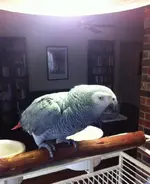Hey, all.
I've not lurked at all, so i don't know much about this place yet.
I've got a 14 yo congo african grey. it was my parents until a couple months ago. they had asked my permission when they first bought it, knowing that i would be caretaker some day. well, they haven't been able to devote as much time as he needs, and after prompting, they agreed to make the transfer.
so after the first month or so, Jake falls off his perch rather ungracefully, and i laugh because he acts goofy sometimes. then a week later, he does it again. twice in one day. and he squawked. that's not right, i think.
then he does it a few days later, and it's obviously an awkward thing that he's not controlling. i need to get that checked out real soon, i think.
today he had what was obviously a seizure. it lasted some 15 seconds, was quite distressing, and he regurgitated a bit. we'll be going to the avian vet immediately. trying to get in tomorrow.
so anyways, i did my homework, found out about calcium deficiencies in the african greys, bought a UVB lamp for him. will boost up on calcium rich veggies, etc. I learned a bit in one day, and one of the best resources was hearing individuals experiences on the net.
So i figured i'd start a thread on this board from our experience, in case it can help anybody else in the future.
I've not lurked at all, so i don't know much about this place yet.
I've got a 14 yo congo african grey. it was my parents until a couple months ago. they had asked my permission when they first bought it, knowing that i would be caretaker some day. well, they haven't been able to devote as much time as he needs, and after prompting, they agreed to make the transfer.
so after the first month or so, Jake falls off his perch rather ungracefully, and i laugh because he acts goofy sometimes. then a week later, he does it again. twice in one day. and he squawked. that's not right, i think.
then he does it a few days later, and it's obviously an awkward thing that he's not controlling. i need to get that checked out real soon, i think.
today he had what was obviously a seizure. it lasted some 15 seconds, was quite distressing, and he regurgitated a bit. we'll be going to the avian vet immediately. trying to get in tomorrow.
so anyways, i did my homework, found out about calcium deficiencies in the african greys, bought a UVB lamp for him. will boost up on calcium rich veggies, etc. I learned a bit in one day, and one of the best resources was hearing individuals experiences on the net.
So i figured i'd start a thread on this board from our experience, in case it can help anybody else in the future.

